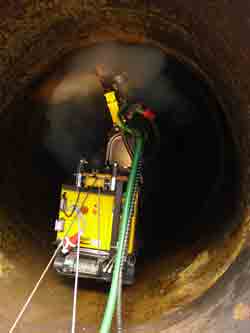The 12MW Glenlee hydro-electric power station in Scotland is part of the 106.5MW Galloway Hydro-Electric power scheme, which was the first large scale integrated hydro-electricity supply complex in the UK when it was built and commissioned in the mid 1930s.
A 60km long network of lochs, dams, tunnels, aquaducts, pipelines and rivers interconnect six power stations in a cascade system, which reuses the water several times for power generation. Each station reuses the water that has been discharged by the one above to generate electricity.
A dam blocks the natural outflow of Loch Doon and acts as the main storage reservoir at the top of the scheme, which has a drop of 210m over its length.
Glenlee is the fifth of the six power stations in the interlinking renewable energy scheme that covers a large area of Galloway and South Ayrshire. Water for Glenlee Power Station gathers in Loch Clatteringshaws and flows through a 6km long tunnel to a portal control valve above the power station. From here water plunges 125m down the hillside through a 570m long steel penstock of varying diameter to the station’s twin 6MW turbines and out of tailrace valves and into a spillway, for discharge into the River Dee. From here the discharged water combines with natural river flows to the downstream Loch Ken, which acts as the reservoir for the last power station in the scheme at Tongland. Outflow from Tongland Power Station rejoins the lower reaches of the River Dee and flows into the Solway Firth at Kirkcudbright Bay.
The Glenlee penstock was in need of cleaning and repainting and power station operator Scottish Power Generation Ltd awarded a contract for its refurbishment to the specialist contractor Concrete Repairs Ltd based in Falkirk. The flange bolted steel pipeline had not been cleaned and painted internally for over 70 years, since it was installed in the 1930s. CRL believed the internal cleaning and paint removal could be done with high-pressure water jetting and contacted N.E.T. Waterjet Ltd, a contractor based in Meigle, Perthshire, specialising in ultra high pressure water technology and diamond drilling and sawing.
N.E.T.Waterjet Ltd’s managing director Tom Wallace believed it was initially feasible to use hand held high-pressure water jetting lances in the penstock’s varying diameters and gradients to remove the old paint coating and peat lying in the bottom, but there was a risk for the operators and so he looked at the possibility of adapting a robot, normally used for the hydrodemolition of concrete, and visited the Conjet factory in Sweden. As soon as he saw the compact 324 Robot he knew it would work, using the optional Hammelmann blast or rotor head instead of the normal concrete hydrodemolition lance.
N.E.T. used its new Conjet 324, with optional rotor head, which arrived on site in May 2010, to remove the build up of debris and old paint coating up to 4mm thick. The company had about 4,200m2 to clean from the inner surface of the penstock in diameters from top to bottom of 3m, 2.7m, 2.4m and twin 1.8m and on varying gradients from 1:100 up to the steepest 18 degrees.
CRL removed the flange bolted expansion joints and butterfly valves in the penstock to provide N.E.T. access at several points for the Conjet 324, which was supplied with water at a pressure of 2,500 bar and flow of 25 litres/min from one of N.E.T.’s existing 250kW Hammelmann 120 high-pressure pumps. “We worked a single shift seven days a week and averaged to clean about 200m2/shift, but our best was 320m2/shift,” said Mr Wallace. “The surface of the pipe actually gets cleaned twice as the 180mm diameter blast head is rotated full circle round the inner circumference of the pipe, then advanced 90mm by the Robot and then rotated back in the opposite direction.
“The sequence is repeated continuously. The Conjet Robot has been superb and worked very well and is a lot safer and about three times faster than using hand lancing. There is no fatigue for the operator and the Robot provides consistent speed and removal. It is also possible to quickly and easily change or adjust the blast head settings and forward step speed to suit the adhesion of the old paint coating.”
There was no dust from the paint removal and the waste water and debris from the Conjet Robot cleaning process flowed down the penstock and was collected by CRL in a sump in the turbine house. It was then pumped into tankers for off site environmental treatment and disposal.
(GK)
Time and date
CONSTRUCTION DIRECTORY
Latest Construction News
15/11/2024
A major milestone has been reached in the UK's transition to a greener energy future. Ofgem has approved the Eastern Green Link 1 project, a £2.5 billion investment that will see the installation of a 196km subsea electricity cable between Scotland and England. The project, a joint venture between ...
15/11/2024
Falkirk Council has secured a £100 million Growth Deal that is expected to create 1,660 jobs and generate £628 million in economic benefits for the area. The Deal, signed by the UK and Scottish Governments, will fund 11 projects, including: • A Carbon Dioxide Utilisation Centre • A Bioeconomy ...
15/11/2024
The Scottish Plant Owners Association (SPOA) has raised concerns that the measures announced in the Autumn Budget could lead to the demise of the plant hire industry in Scotland. The association argues that the increased tax burden and other economic pressures will have a significant negative ...
15/11/2024
Maxi Construction has been awarded a £1.6 million contract by The City of Edinburgh Council to replace the Reinforced Autoclaved Aerated Concrete (RAAC) roof at Pentland Primary School. The phased project will involve the removal of existing roof coverings and ceilings, the replacement of RAAC ...
15/11/2024
Clark Contracts has been awarded a contract to retrofit Scotland's National Retrofit Centre at BE-ST's Innovation Campus. The project aims to transform the building into a living laboratory, showcasing best practices in non-domestic retrofit. The ambitious project will involve a range of ...
15/11/2024
The Scottish Government has announced plans to bypass the villages of Springholm and Crocketford on the A75, a key route linking Scotland to Ireland. Jacobs UK Ltd has been awarded a contract to undertake initial design and assessment work for the bypass. The project is funded by the UK ...
15/11/2024
Dundee City Council has secured a £693,383 grant from the Scottish Government's Recycling Improvement Fund to upgrade its recycling facilities at Baldovie and Riverside. The funding will be used to purchase new waste management equipment, such as roll packers and compactors, to improve efficiency ...
15/11/2024
Homes for Good and Glasgow Credit Union have formed a partnership to address housing inequality in Glasgow and neighbouring areas. Glasgow Credit Union has provided a £2.4 million loan to Homes for Good, which will be used to purchase up to 35 homes for low-income individuals and families. The ...
15/11/2024
The historic Troon station has reopened following a £5m restoration project. The station was extensively damaged by a fire in 2021. Network Rail, in partnership with AmcoGiffen and CPMS, undertook the rebuild, which included the restoration of the station's iconic façade while incorporating modern ...
15/11/2024
BEAR Scotland, on behalf of Transport Scotland, is undertaking emergency works on the A828 between Ledaig and Benderloch to address a safety concern related to a deteriorating rock face. Recent monitoring has identified a fractured rock mass 60 metres above the road, requiring urgent attention. To ...


















